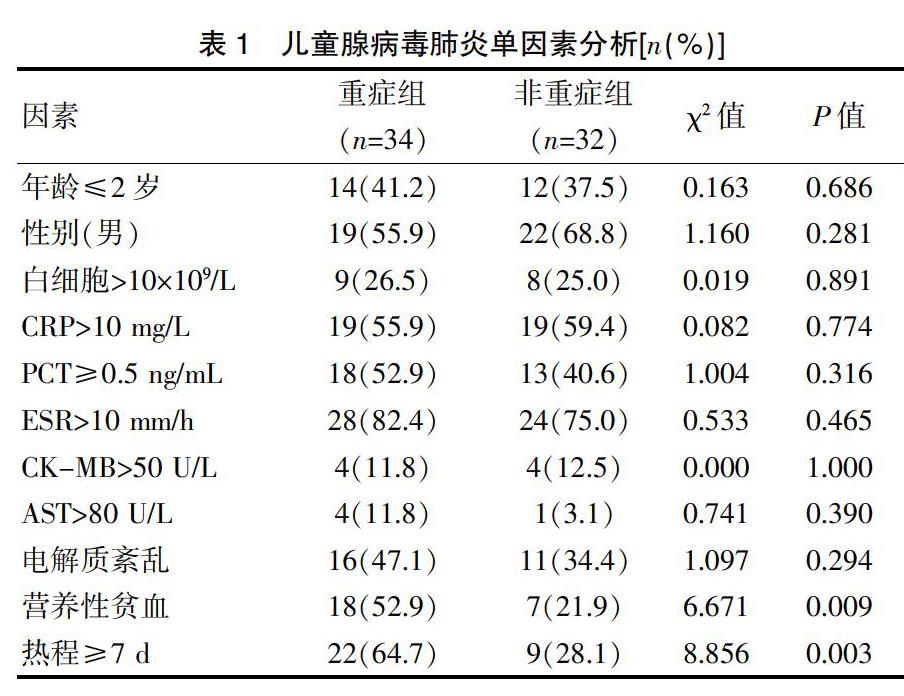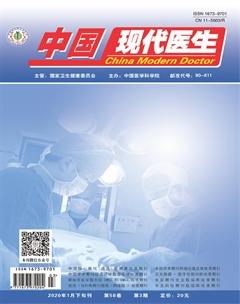儿童重症腺病毒肺炎的危险因素分析
刘君 王团美


[摘要] 目的 分析儿童重症腺病毒肺炎的危险因素。 方法 收集2019年6~8月在长沙市中心医院儿科住院的66例腺病毒肺炎患儿的临床资料,其中34例为重症腺病毒肺炎、32例为非重症腺病毒肺炎,对两组11个可能的危险因素,包括年龄、性别、白细胞、C反应蛋白(CRP)、降钙素原(PCT)、血沉(ESR)、肌酸激酶同工酶(CK-MB)、谷草转氨酶(AST)、电解质紊乱、营养性贫血、热程≥7 d先进行单因素分析,然后对单因素分析中差异有统计学意义的危险因素进行Logistic回归分析。 结果 多因素Logistic回归分析显示:营养性贫血(OR=4.597)和热程≥7 d(OR=1.289)是儿童重症腺病毒肺炎的独立危险因素。 结论 营养性贫血和长热程是儿童重症腺病毒肺炎的独立危险因素,及时进行相关干预治疗,可减少重症腺病毒肺炎的发生。
[关键词] 腺病毒;重症肺炎;危险因素;儿童
[中图分类号] R725.6 [文献标识码] B [文章编号] 1673-9701(2020)03-0057-03
[Abstract] Objective To analyze the risk factors of severe adenovirus pneumonia in children. Methods The clinical data of 66 children with adenoviral pneumonia admitted to the pediatrics department of Changsha Central Hospital from June to August 2019 were collected. Among them, 34 were severe adenovirus pneumonia and 32 were non-severe adenovirus pneumonia. Eleven possible risk factors for both groups, including age, gender, white blood cells, C-reactive protein(CRP), procalcitonin(PCT), erythrocyte sedimentation rate(ESR), creatine kinase isoenzyme(CK-MB), and aspartate aminotransferase(AST), electrolyte imbalance, nutritional anemia, heat history ≥7 days were first analyzed by univariate analysis, and then the risk factors with statistically significant differences in univariate analysis were analyzed by Logistic regression analysis. Results Multivariate logistic regression analysis showed that nutritional anemia(OR=4.597) and heat history≥7 days(OR=1.289) were independent risk factors for severe adenovirus pneumonia in children. Conclusions Nutritional anemia and long heat history are independent risk factors for severe adenovirus pneumonia in children. Timely interventional treatment can reduce the occurrence of severe adenovirus pneumonia.
[Key words] Adenovirus; Severe pneumonia; Risk factors; Children
腺病毒肺炎是兒童社区获得性肺炎中较为严重的类型之一,多发病于6个月~2岁儿童,多以发热、咳嗽、呼吸困难、精神萎靡、嗜睡、面色苍白等为主要临床表现[1],占社区获得性肺炎住院儿童的8.55%[2],重症腺病毒肺炎进展快、症状重、病死率高、预后差,是造成婴幼儿肺炎死亡及致残的重要病因之一。本文回顾性分析了2019年6~8月在长沙市中心医院住院的66例腺病毒肺炎住院患儿的临床资料,找出能协助早期诊治重症腺病毒肺炎的临床表现及实验辅助检查,早期诊治,以降低病死率、改善预后,现报道如下。
1 资料与方法
1.1 一般资料
选取2019年6~8月在长沙市中心医院儿科住院的66例腺病毒肺炎住院患儿,其中男41例,女25例,年龄3个月~11岁,平均(3.03±1.98)岁,热程0~19 d;按肺炎程度分为重症组34例(51.5%)和非重症组32例(48.5%)。纳入标准:肺炎及重症肺炎诊断标准参照2019年国家卫生健康委制定的《儿童社区获得性肺炎诊疗规范》[3],通过免疫性荧光定量法对患儿鼻咽物、分泌物、吸出物进行腺病毒抗原或腺病毒核酸检测阳性,并排除异物吸入史、严重肝肾功能不全、血液系统疾病等。
1.2 方法
将11个可能的危险因素,包括年龄、性别、白细胞、CRP、PCT、ESR、CK-MB、AST、电解质紊乱、营养性贫血、热程≥7 d等。入院时抽取患儿静脉血检测血常规、肝功能、心肌酶、电解质、血沉、降钙素原等,以获取相关生化观察指标结果。

